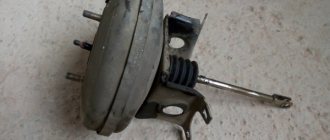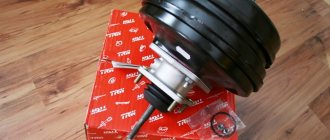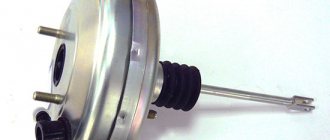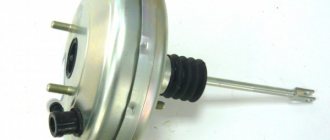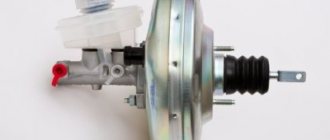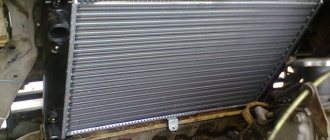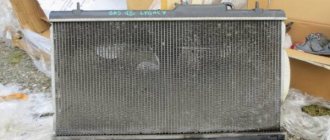The main sign indicating to the driver that the vacuum booster is faulty is difficult movement of the brake pedal, which in turn affects the quality of braking and, as a consequence, the safety of driving. Vacuum amplifiers can only be repaired using special equipment; if you don’t have such equipment, you will have to replace it completely, but before that you need to check the quality of its operation and the operation of the check valve, and only after that make a decision about either replacement or repair.
To check the operation of the vacuum booster, press the brake pedal several times, creating pressure in the system, and the brake pedal should lock in the upper position. Now, without releasing the pedal, start the engine. At the moment of startup, if the amplifier is working properly and the tightness of the connection of the vacuum hoses is not broken, the pedal will go down. If it does not go down, then first of all we check the quality of the connection of the vacuum hose and the tightness of the check valve.
To check the check valve on a VAZ 2109 car, you need to do the following sequence of actions:
- First of all, as mentioned above, we check the tightness of the connection of the hoses with the fitting on the inlet pipe and the check valve on the amplifier.
- Next, you can start checking the valve itself, first disconnect the hose from it and pry it off with a flat screwdriver, remove it from the amplifier.
- In the next step, we will need any rubber bulb, the only two conditions: the bulb must be sealed and it must fit the diameter of the valve fitting. A hydrometer is quite suitable for this role.
- Having pulled it onto the fitting, we squeeze the bulb with our hand, thereby releasing air through the valve and releasing it. If the bulb remains compressed, then the valve is working properly, that is, it holds the vacuum. Otherwise, it must be replaced. As an option, you can try to blow out the valve with your mouth, that is, first we blow it out, so the air should come out freely, and then we suck it in and, as a result, the air should not pass through.
This completes the process of checking the vacuum booster and check valve of the VAZ 2109. If the tightness of the hoses is not broken, and the valve itself is working properly, then you will have to change the amplifier.
Servicing VAZ 2109 brakes: replacing a faulty “vacuum seal”
vacuum booster The vacuum booster, which “lightens” the brake pedal, is a toroid divided by a diaphragm into two chambers: one is permanently connected to the intake manifold, the other is connected to the atmosphere when the pedal is pressed. The “assistant” is mounted in the engine compartment behind the main brake cylinder and is connected to the brake pedal through a rod.
Node examination
The need to replace the vacuum booster on a VAZ 2109 should already be stated in the event of an increase in the force applied to the brake pedal. However, a simple check will help ensure the correctness of the diagnosis:
- turn off the engine;
- press the brake pedal 5-6 times;
- hold down the brake pedal;
- start the engine.
The identifier of a serviceable VUT is an immediate, noticeable movement of the brake lever forward.
An alternative symptom will help diagnose a unit malfunction: when the engine is running, a “hissing” can be heard under the hood in the area where the intake manifold pipeline connects to the VUT check valve fitting. Experienced specialists additionally prefer to check:
- integrity of the suitable pipe; tight fit of the main element on the fitting (hissing may appear as a result of a loose connection).
The initial stage of failure of the vacuum booster is especially clearly identified on “nines” with a carburetor power system. The brake pedal is activated, as expected, with a light force, braking is good and informative, but:
- at idle speed the engine “troits”;
- when you press the brake pedal, the idle speed stabilizes;
- after applying pressure to the accelerator in neutral gear, “dips” occur, regardless of carburetor adjustments.
If the symptoms described above are present, it is advisable to remove the pipe from the “vacuum manifold” fitting with the engine running and plug the hose with a suitable object or finger - the idle speed has returned to normal and, therefore, replacing the vacuum booster on the VAZ 2109 is inevitable. If a malfunction is detected along the way in this way, the movement should be continued with the VUT turned off: the pedal will be hard, but the information content will remain.
Signs of amplifier failure
You will be interested in: TFSI engine: decoding of the designation, features and characteristics
There are several signs that can indicate a malfunction of the vacuum brake booster on the VAZ-2109:
- Stopping efficiency is very low. When you press the pedal you don't feel any braking happening. It becomes almost impossible to stop the car. Sometimes there is a strong kickback in the pedal.
- The brake pedal becomes too heavy and difficult to press.
- There is a significant drop in crankshaft rotation speed when the pedal is pressed.
If the first two signs of VUT failure occur, it is necessary to diagnose the element. It is not a fact that it was the amplifier that failed.
If there is a drop in the crankshaft rotation speed when you press the brake pedal, you need to check whether there is air leakage in the engine intake tract. Be sure to inspect all vacuum hoses. When air is not sucked in, we can talk about a breakdown in the design of the amplifier. Later in the article we will talk about replacing the vacuum brake booster on a VAZ-2109.
Before starting work, preparations need to be made. It is best to install the machine on a level area. There should be enough space near the driver's door so that it can open freely. It is also recommended to completely disconnect the battery - it can interfere with dismantling the mechanism.
How to replace a defective vacuum booster on a VAZ 2109: list of actions
The initial task of repair is to disconnect the pedal from the amplifier rod. Dismantling is carried out in the area of the pedal assembly: it is necessary to disconnect the two units connected to each other by a pinned pin using a flat-head screwdriver.
Further work is carried out in the engine compartment:
- disconnect the power supply connector for the brake fluid level sensor;
- dismantle the bracket that secures the hydraulic lines relative to the car frame (unscrew the nut with a head to “10”);
- disconnect the main brake cylinder by unscrewing the two nuts securing it to the VUT using a 17" wrench.
Note. When changing the brake booster, do not disconnect the hydraulic lines from the master cylinder. The lengths of the pipes make it possible to move the unit outside the working area.
After access to VUT is opened, the plan for replacing the vacuum booster of the VAZ 2109 brake system comes into force, including the following measures:
- disconnect the pipe connecting the amplifier chamber to the intake manifold;
- remove the front strut strut (installed additionally);
- unscrew the four nuts that secure the amplifier housing to the body studs (use a set of wrenches + extension + universal joint + head on “13”);
- remove the assembly from the studs and remove it from the engine compartment.
operating principle On the back side of the amplifier (on the drive fork side) a seal is installed and a bracket is attached, through which the unit is connected to four studs on the car frame. The parts must be dismantled: it is enough to unscrew the two fastening nuts with a “17” head and remove the iron structure by moving it towards you. The boot is easily pulled off the stem.
Having mounted the mounting bracket and rubber seal on the new amplifier, you can begin installing the VUT, which proceeds according to the reverse scenario. When installing, you should pay attention to three facts:
- The vacuum booster rod should be connected to the brake pedal immediately after the unit is seated on the mounting studs (before tightening with nuts);
- experienced owners additionally apply sealant between the brake cylinder and the VUT, indicating the imperfection of the sealing elements;
- the VUT rod acting on the main brake cylinder (located on the front side of the housing) may move during transportation or installation (it is necessary to check and, if necessary, install correctly by pressing until it stops).
For your information. An incorrectly installed actuator rod will result in the brakes not working after assembly.
This is interesting: Adjusting the K68 carburetor
Rules mandatory for compliance with the installation of a new VUT
When installing a new vacuum mechanism, consider the following rules:
- the VUT rod is connected to the brake pedal after placing the device on the fixing pins;
- to perfect the sealing components, lubricate the space between the brake cylinder and the vacuum device with sealant;
- the VUT rod in the VAZ-2109, which affects the main brake cylinder located on the front side of the frame, can move during transportation or installation. Therefore, to check the condition of the product, press it all the way.
Determining the correct installation of the vacuum brake booster is not difficult - the brake pedal, if the product is installed correctly, works without failure.
Video instructions on how to replace the vacuum brake booster in a VAZ-2109 with your own hands are presented below:
0 0 votes
Article rating
Replacing the main brake cylinder on a VAZ 2109
The vacuum brake booster (VUT) makes it easier to operate the brake pedal. This assembly is divided into two chambers - one has a permanent connection with the intake manifold, and the second is connected to the atmosphere when the brake pedal is pressed.
The unit is located under the hood behind the brake master cylinder. Through the rod it is connected to the brake pedal.
Checking status
The corresponding signs may indicate the need to change the vacuum booster or the brake master cylinder.
The primary sign of VUT failure is an increase in the force that must be applied to the pedal to brake.
To be sure of the problem, perform the following check:
- Turn off the engine;
- Press the brake pedal 5-6 times in a row;
- Press the pedal to the floor;
- Start the engine;
- If the VUT is working properly, the pedal will immediately go up.
Checking the condition
If you have a VAZ 2109 carburetor engine under the hood, you can determine the VUT malfunction a little differently in the initial stages:
- Initially, the pedal will work normally, you will have to apply a little force, braking occurs normally;
- But at the same time the engine stalls at idle;
- When you press the brake pedal, the idle speed calms down;
- By pressing the gas in neutral gear, failures occur in the carburetor;
- If such symptoms are observed, with the engine running, remove the pipe from the VUT fitting and plug it with your finger or other available tool;
- Has the idle speed stabilized? In this case, replacing the vacuum seal cannot be avoided.
If such a malfunction is detected while driving, you can continue driving only if the VUT is turned off.
Initial stage of dismantling
Let's move closer to removing the element. When replacing a vacuum brake booster on a VAZ-2109 (the price of a new one is 800-1000 rubles), you will need a minimal set of tools; there is no need to drain the fluid from the system. Be sure to make sure that the new amplifier is of proper quality. Subsequently, during installation, follow all the recommendations given in the article.
First you need to disconnect the brake booster rod from the pedal. Before this, you need to remove the cotter pin that connects the amplifier rod and pedal. Please note that on one side there is a locking bracket that must be removed using pliers. Then you need to disconnect the hose from the amplifier in the engine compartment. To do this, you just need to remove it from the fitting using a little force. You don't need to use any tools.
Choice
We will give some recommendations regarding the choice of a new vacuum amplifier.
Selection criterion
Required parameters
The cost of a good vacuum cleaner is now about 2.5 thousand rubles. These are not the most expensive, but not the cheapest Chinese options. Optimal for VAZ 2109
This packaging, used by a genuine manufacturer, is made of corrugated cardboard
The label should be clearly legible - the production batch number, the production date of the part and the name of the manufacturer itself
You should not buy from market traders. There are many good, trusted spare parts stores in any city. Don’t be shy to ask for certificates, documents for parts
Choosing wisely
Now there are a lot of fakes on the market. Such parts cost the same as the originals, but last much less.
Replacement of VUT
First, remember that repairing the vacuum booster is impossible. This unit is removed and replaced with a new one. In theory and in practice, some do. But at your own responsibility.
Now about the replacement itself.
- Disconnect the brake pedal from the booster rod. The units are connected to each other by a pin. Dismantling is carried out in the area of the pedal assembly and here you will need a simple flat-head screwdriver.
- Let's go and open the hood.
- Disconnect the power supply to the brake fluid level sensor.
- Remove the bracket that holds the hydraulic lines to the frame. A 10mm socket is useful, which is used to unscrew the nut.
- Disconnect the brake master cylinder. To do this, unscrew the 2 nuts holding it to the vacuum unit. Assess the condition of the GTZ. If necessary, replace it too.
- It is not necessary to disconnect the hydraulic lines from the brake cylinder (master). The pipes are quite long, so they can easily be moved to the side so that they do not interfere with the work process.
- Disconnect the pipe that connects the vacuum chamber to the intake manifold.
- Remove the spacer from the front struts.
- Unscrew the 4 nuts that hold the vacuum housing to the car body studs.
- Remove the unit from the studs and pull it out through the engine compartment.
- On the drive fork side, there is a seal with a bracket on the return of the amplifier. He secures the assembly to the frame with 4 studs. They need to be removed. To do this, use a 17mm head to remove 2 nuts, after which the iron structure is removed. Just pull it towards you. Be sure to pull the boot off the stem.
- Install the mounting bracket and a new rubber seal onto the new vacuum booster. Now you can begin full reverse assembly.
Replacing the device
Reassembly
If you decide to dismantle and reassemble yourself, be sure to follow several recommendations when installing a new VUT:
- The vacuum rod and the brake pedal are connected to each other immediately after the device is seated on the mounting studs. That is, before they started tightening the nuts.;
- Experienced VAZ 2109 owners recommend applying sealant between the vacuum brake booster and the brake cylinder. This is due to imperfect design;
- The vacuum rod, which acts on the main brake cylinder, may move during transportation of the part. Also, displacement often occurs during the installation process. Therefore, be sure to check this fact and install it correctly if necessary. To do this, press the rod all the way.
If the stem is not installed correctly during assembly, the brakes simply will not operate properly. The consequences are hardly worth talking about.
Installing a new amplifier
Reverse the installation procedure. First secure the bracket. Be sure to put a rubber casing on the rod, which will not allow dust to seep into the mechanism. Then the vacuum body along with the bracket is installed on the car.
Now you can tighten the nuts. Pay attention to how the brake booster rod and pedals are connected. It happens that the cotter pin fits tightly, after which the pedal may not return. In this case, it is necessary to reduce the cotter pin slightly in diameter using a file.
Finally, check the tightness of all threaded connections. Make sure the vacuum hose is installed correctly. After which you can start operating the car. The new vacuum brake booster on the VAZ-2109 can last 5 years or more, depending on the intensity of use of the car.
Master brake cylinder
It is not uncommon to discover problems with the master cylinder when checking the condition of the brake assembly.
When changing the vacuum seal, it would be logical to study the current state of the gas turbine engine and, if necessary, replace it.
The replacement procedure itself is as follows.
- Disconnect the negative terminal from the battery.
- Disconnect the wire block from the fuel oil level sensor. It is located in the tank and is built directly into the lid.
- Use a special wrench for brake pipes to loosen their tension. There is no need to unscrew it completely.
- Unscrew the pair of nuts that secure the GTZ to the vacuum chamber. Only now can the brake pipes be completely unscrewed.
- Remove the cylinder from the studs.
- If necessary, remove the brake fluid reservoir itself at the same time. To do this, you need to carefully rock the tank and remove the leg from the bushing.
- Assess the condition of the removed cylinder. Also be sure to check for any defects on the tank. If there are any, be sure to replace the brake fluid reservoir with a new one.
- Armed with a new GTZ, put it in place and tighten the nuts. Fasteners can be fully tightened immediately.
- Install the reservoir and fill it with brake fluid to the maximum mark.
- Now a very important step is to extract air from the cylinder. To do this, you need to close the holes in the front brake pipes with your fingers. At the same time, your assistant should gently, but not sharply, press the brake pedal. This will create pressure in the system. Continue this manipulation until you feel liquid coming out of the holes.
- As soon as the liquid flows, put on the tubes, install and fix them in place. In this case, the brake pedal cannot be released.
- By analogy, the rear tubes are connected. When they are installed in place, there must be pressure in the system, that is, the brake pedal is pressed to the floor.
After completing the replacement of the turbocharger, do not forget to bleed the brake system according to the rules.
Disassembling the unit with the TJ tank
It is quite possible to change the vacuum seal and cylinder with your own hands. The work will take a few hours, but will save a lot of money on visiting a car service center.
Vacuum brake booster VAZ 2109
The braking system of a car is the dominant one in terms of diagnostics by the driver, since driving safety directly depends on its effective operation.
This is interesting: Rubber wheel guards for parking
One of the key units in this system is the vacuum brake booster. Its task is to create additional air pressure through vacuum in the brake system and increase braking efficiency.
Efficiency of use
The VAZ 2109 model was one of the first domestic cars to receive such a unit as standard equipment (before that, not all cars were equipped with an amplifier). This innovation has significantly improved the efficiency of driving and reduced its braking distance, regardless of the road surface.
Braking efficiency with this unit increases on average by 30-40%, depending on the specific model and road conditions.
On video of the VAZ 2109 vacuum brake booster:
Adviсe
The brake booster was replaced, but there are some nuances. There is a stop in the center of the hole in this unit, which may become crooked during assembly, and you will assemble it incorrectly. So pay attention to this. It is also advisable to coat the joint with the cylinder with sealant, although this is not provided. This is what the rubber O-ring is for. But it happens that it does not fit tightly and can allow air to pass through where the studs exit. It also needs to be lubricated, and it is recommended to seal all mating parts during assembly.
vote
Article rating
Device and application
The brake booster is made in the form of a single block part (round in shape with two rods). Structurally, this block is divided into two unequal parts, each of which performs a specific function.
One side of the amplifier is directly connected to the master cylinder, while the other faces the driver (connects directly to the brake pedal).
The part that faces the brake pedal and ends in a chamber through the rod, which is connected to the rest of the part. Such a chamber is called atmospheric.
Another chamber in the block body is called vacuum.
Each of the cameras performs its own specific function. The atmospheric valve, when the gas pedal is pressed, comes into contact with the atmosphere and builds up pressure, which is why the gas pedal has an easy move.
On video how to check the vacuum brake booster of a VAZ 2109:
In the released position, the valve is at rest and is connected to another part of the amplifier (vacuum chamber). On the opposite side, the vacuum chamber is connected to the brake cylinder through a rod and, when the brake pedal is pressed, creates pressure in the form of vacuum through the valve.
The vacuum is created by a vacuum region through a valve, which in this case is located close to the intake system (intake manifold). Thus, when you press the gas pedal, both chambers interact through the valves, acting on the master brake cylinder and making it easier to control the car.
Final dismantling
Now you will have to unscrew the two nuts that secure the brake master cylinder to the booster housing. After this, you need to move it as far as possible, but try not to break the tubes. There is no need to do extra work, unscrew all the lines that connect the main cylinder to the actuators on the wheels. Since in this case you will have to pump the entire system. The vacuum seal can be removed quite simply, you just need to move the brake cylinder away.
Then unscrew the four nuts that secure the amplifier housing to the body. To be more precise, there is still a bracket between it and the body. It is he who is fixed to the body. This is where the hardest part awaits you. Access to fasteners is very problematic, so you will have to sweat a little.
Once you unscrew all the nuts, you need to remove the amplifier from under the hood. And finally unscrew the amplifier bracket. These are two nuts, unscrewing them is not very difficult.
Before checking the vacuum brake booster of the VAZ-2109, make sure that the intake tract creates a vacuum. Without it, the amplifier mechanism will not be able to work.
Fault diagnosis
Driving without a brake booster is at least dangerous, since the braking distance is structurally calculated taking into account the operation of this unit. If it malfunctions, this indicator significantly worsens, the driver loses control over the behavior of the car, which in many cases leads to traffic accidents.
Therefore, diagnosing and timely replacement of this unit is the responsibility of every conscientious driver.
Diagnosing a faulty vacuum brake booster is not a complicated procedure.
For video repair of a vacuum booster:
Even while driving, there is a uniform method for checking functionality:
- If, when moving at any speed, the gas pedal is very tight, there is a clear problem with this particular unit. Failure can be caused either by a design defect in the unit itself (manufacturing defects) or by mechanical damage (failure of operating valves, breakage of one of the diaphragms);
- The deterioration of the braking properties of the car in this case, when the brake booster breaks down, the effect of the brake pedal is necessarily reinforced by a significant deterioration in the braking distance in relation to the working version.
VESKO-TRANS.RU
AutoNews / Reviews / Tests
How to change the vacuum chamber on a VAZ 2109
Welcome! Vacuum brake booster.
It is attached to a bracket on the engine cover (this is the board that separates the engine compartment and the interior) and has a master cylinder, which, by the way, also needs to be replaced from time to time (when this cylinder wears out, the problem begins with the brakes, the car may not brake, only two of the four wheels can brake, the brake fluid can still flow out quickly and the cylinder can leak), thanks to this cylinder and thanks to the vacuum booster. Braking happens on modern cars, by the way, the vacuum cleaner works thanks to the intake manifold (on injectors, thanks to the receiver), so When you start the engine, the brakes are soft and very easy to apply and when you turn it off, the air pressure in the intake manifold disappears and the pedal becomes (noticeably) strong. The note! Anyone with at least some car repair experience will be able to replace this brake booster, and to replace it you will need a small but still rare set of tools that not everyone will find, namely: pliers you will need a wrench with a nut and bracket head sockets (if there is an extension cord, it’s better to stock up on them), if you don’t have a collar, then take all the keys you have, thanks to the cover and the wrench, you can also remove it, but it won’t be very convenient!
Result:
Where is the vacuum brake booster? In the engine compartment, it is located on the engine cover (marked with a red arrow), and behind the engine panel is the interior of the car, in the interior of which there is a brake booster pushrod, which is connected to the brake pedal. (When you remove the booster, you have to turn it off, and so it is very easy to determine the approximate location of the brake booster from the cab. When you go to remove the booster with this pushrod, you will immediately know which pushrod it is.
When should I replace my brake booster? If the brake booster or brake faults disappear, or the engine starts to idle rough, there are actually many symptoms, because on each car, the brake booster fault is always detected differently, on some cars with the engine off, which when the pedal starts to press with one effort, in which when you press the pedal, the idle speed will be disrupted and the car will be delayed, but the check is always the same, with the engine off, you need to press the brake pedal 5-6 times, the last time you need to leave the pedal pressed and start the engine, and, as As soon as it starts, the pedal should be a little out of order, if so, then the amplifier will work.
The note! You will get acquainted with all the malfunctions of a vacuum brake booster, you can in the video clip located just below, it shows the whole example on a classic car, but the point is that this booster works the same on all cars (they are only removed in different ways, and that’s all they have the same principle of operation), and therefore, if you have a front-wheel drive, and the video talks about all-wheel drive in general, then do not pay much attention to it, because we have already said that the principle of the vacuum booster is the same on all cars!
Replacement and cost
In any situation when a breakdown is detected, timely replacement of the entire assembly is necessary. It is possible to correct some shortcomings in the form of replacing the valve, but this procedure may not bring a lasting effect, since the part itself in many cases (if we talk about the VAZ 2109 model) must be replaced due to its advanced age. After installing a new part, be sure to make adjustments.
Breakdowns of vacuum amplifiers do not happen so often with this model, however, due to their age (production of the model was discontinued in 2004), the amplifiers gradually wear out and become unusable over time.
On video of a malfunction of the vacuum booster:
There are many suppliers of parts for VAZ cars on the market. The average price (cost) of a new amplifier is about 2000 rubles.
